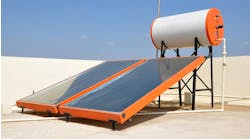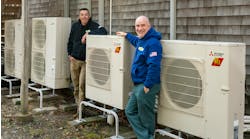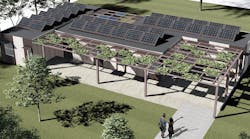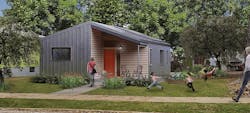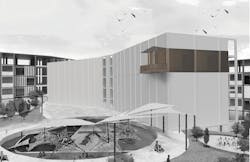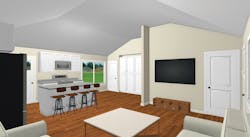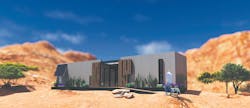Latest from Solar
Sponsored
Normally, this past June, residents and visitors to our nation’s capital would have witnessed college students from all over the country—and the world—construct their vision of a net-zero home on the National Mall. Students would have competed against their peers in various challenges designed to test their homes' comfort and performance.
The public would have toured the eco-friendly houses, learning from the students how the different systems worked. And as points were tallied up, there would be time for celebration for the winners, yes, but also for these extraordinary young people who have a clear vision of what they want their future to look like.
But 2020 is not a normal year, and we did not have a normal summer. The novel coronavirus SARS-CoV-2, which causes the highly infectious COVID-19 disease, struck U.S. shores early this year, although there is some speculation it may have arrived earlier. By March, as more people were taken ill, some dying, it was clear that large groups congregating, indoors or outdoors, was ill-advised during a pandemic.
The U.S. Department of Energy, which sponsors the Solar Decathlon, announced in May that it would postpone this year’s Build Challenge, initially scheduled for June, to April 16-18, 2021. The venue will be moved from the National Mall in Washington to the National Renewable Energy Laboratory in Golden, Colo., where it will coincide with the 2021 Design Challenge.
Select top-performing teams will also be invited to exhibit at the National Association of Home Builders’ International Builder’s Show, Feb. 9-11, 2021, in Orlando, Fla.
The 2022 Build Challenge will take place in 2023.
The Design Challenge is a one- or two-semester design-only competition. In contrast, the Build Challenge is a two-year design-build competition that is now transitioning to have all teams build their solutions in their own communities, rather than display full structures at a central event.
Teams in both the Design Challenge and Build Challenge compete in 10 contests: energy performance, engineering, financial feasibility and affordability, resilience, architecture, operations, market potential, comfort and environmental quality, innovation, and presentation.
Build Challenge Projects
The current Build Challenge has nine teams in the competition:
• Hogeschool Utrecht University of Applied Sciences Utrecht, Utrecht, Netherlands: The team’s concept will be “circular, eye-opening, limitless, community, innovative, unconventional, and self-sufficient.”
• Kansas State University, Manhattan, Kan.: The university’s Net Positive Studio team is collaborating with Build SMART, a building panel manufacturer, which supports the effort to “integrate prefabrication building technology, net-zero energy performance and affordability.”
The team’s long-term goal of the studio is to work with groups and neighborhood leaders to “develop and propose feasible, affordable, and high-quality housing models for [Kansas City’s] Historic Northeast neighborhood that can be immediately adopted for implementation.”
• Universidad Técnica Federico Santa María, Valparaíso, Chile: The Casa Metamorfosis project is a single-family unit of a multifamily development that is “innovative, cost-effective, and energy-efficient.” The team has taken a “latent and existing housing problem in Santiago (gentrification) to inform the proposal's design and groundwork.”
• University of Colorado, Boulder, Colo.: This team’s project focuses on mountain communities, which face short building seasons, contractor shortages, and the need for affordable homes for permanent residents and seasonal workers.
The goal is to “demonstrate fast and affordable methods like prefabrication and use of an accessory dwelling unit; integrate systems to reduce energy, maintenance and recovery costs in a harsh climate; and model supplemental homeowner income through accessory dwelling units to motivate local investment.”
• University of Denver, Denver: The team is developing a cost-effective plan “following Federal Emergency Management Agency guidelines in transforming a 1950s home, located in a floodplain, into the modern age.
“An Accessory Dwelling Unit to the rear of the property will also meet FEMA guidelines for building in a floodplain, add density to help meet increased housing demands for the local community, and significantly improve the owner's ability to generate cash flow.”
• University of Illinois at Urbana-Champaign, Urbana, Ill.: This team is building a prefabricated house focusing on adapting to changing lifestyles.
The “ADAPTHAUS is an inexpensive option for young adults that would allow for home expansion in accordance with the demand for space. Additional modules can be purchased with the introduction of a nuclear family; the same units can be offloaded or repurposed with space demand shifts. This allows for the maintenance of a single home throughout the homeowner's life.”
• University of Nevada-Las Vegas, Las Vegas: Desert Bloom is the name of this team’s self-sufficient, affordable home for a military veteran—"a place of healing and respite for veterans dealing with the effects of wartime trauma.” The house “connects residents to their environment through a carefully orchestrated procession of sensory experiences” and “celebrates rituals of daily life in the Mojave Desert.”
• University of Waterloo, Waterloo, Ontario, Canada: This team works on the Kaikaiknong Crescent Development project with the Chippewas of Nawash Unceded First Nation community.
The design is for a four-bedroom single-family home to “address families' cultural and societal needs within the Chippewas community. Our team hopes the design will not only attain affordable and net-zero energy ready status but also provide a family with pride of ownership in a home that is resilient, comfortable and adaptable.”
• Weber State University, Ogden, Utah: This team's primary goal is to “create the most sustainable, environmentally friendly home that we can. We want this home to be affordable and fit for the 21st century.”
Winners of 2020 Virtual Design Challenge
Instead of networking with colleagues from other schools, students from 45 teams, representing 31 collegiate institutions, competed for the top prizes, virtually, in April.
• Grand Winners
1. Commercial: University of Oregon (Eugene, Ore.)
2. Residential: Miami University (Oxford, Ohio)
• Suburban Single-Family Division
1. First place: Monash University (Melbourne, Australia)
2. Second place: Universidad Tecnológica Indoamérica (Quito, Ecuador)
3. Honorable mention: The Pennsylvania State University (Centre County, Pa.)
• Urban Single-Family Division
1. First place: The University of British Columbia (Vancouver, British Columbia)
2. Second place: University of California Los Angeles (Los Angeles)
3. Honorable mention: Ball State University (Muncie, Ind.)
• Attached Housing Division
1. First place: Miami University
2. Second place: Southeast University (Nanjing, Jiangsu Province, China)
3. Honorable mention: Thomas Jefferson University (Philadelphia, Pa.)
• Mixed-Use Multifamily Division
1. First place: The University of Arizona (Tucson, Ariz.)
2. Second place: Thomas Jefferson University
3. Honorable mention: Illinois Institute of Technology (Chicago)
4. Honorable mention: State University of New York College of Environmental Science and Forestry (Syracuse, N.Y.) and Syracuse University (Syracuse, N.Y.)
• Elementary School Division
1. First place: University of Oregon
2. Second place: Purdue University (West Lafayette, Ind.)
3. Honorable mention: The University of Arizona
• Office Building Division
1. First place: Illinois Institute of Technology
2. Second place: Ryerson University (Toronto, Ontario)
3. Honorable mention: Virginia Polytechnic Institute and State University (Blacksburg, Va.)
Upcoming Challenges
Student teams wanting to participate in the Solar Decathlon 2021 Design Challenge have until Oct. 20, 2020, to apply. The addition of the Retail Building Division for 2021 expands the types of commercial buildings students can design. Finalist teams will present their projects to a jury of experts April 16–18, 2021, at the National Renewable Energy Laboratory.
For the 2023 Build Challenge, rather than transporting the structures to a central venue, teams will construct and display their homes in their local communities as they are doing for the 2020/2021 competition. While the homes will be built and evaluated locally, the teams will gather for an in-person event and final round.
The Embodied Environmental Impact Contest, which was first piloted in the 2020 Design Challenge, has been officially integrated into the competition. It evaluates the full lifecycle energy and environmental impacts of each competitor’s building, including effects associated with selected materials, construction processes, and end-of-life reuse or disposal.
Student teams can find rules and guidance for both challenges in the Solar Decathlon Competition Guide (https://bit.ly/3nlpxn1). Teams can apply for either contest at www.solardecathlon.gov/about-apply.html.
Kelly Faloon is a contributing writer to Contractor magazine. The former editor of Plumbing & Mechanical magazine, she has more than 30 years’ experience in B2B publishing; 22 of those years were spent covering the plumbing, heating, cooling and piping industry. A native of Michigan’s northern Lower Peninsula, Faloon is a journalism graduate of Michigan State University.
[Sidebar]
Solar Decathlon Impact
Since 2002, the design and build challenges of the U.S. Department of Energy Solar Decathlon have:
• Involved more than 465 collegiate teams, which pursued a multidisciplinary approach to study the requirements for designing and building energy-efficient houses powered by renewable energy.
• Established a worldwide reputation as a successful educational program and workforce development opportunity for thousands of students.
• Positively impacted more than 23,000 collegiate participants.
• Involved more than 23 countries.
• Expanded to Europe, China, Latin America, Africa, and the Middle East to involve hundreds more teams and more than 19,000 participants through Solar Decathlon Europe 2010 and 2012 (Madrid, Spain), Solar Decathlon Europe 2014 (Versailles, France), Solar Decathlon Europe 2019 (Szentendre, Hungary), Solar Decathlon China 2013 (Datong) and 2018 (Dezhou), Solar Decathlon Latin America and Caribbean 2015 and 2019 (Cali, Colombia), Solar Decathlon Africa (Morocco), and Solar Decathlon Middle East 2018 (Dubai, United Arab Emirates). In 2019, three Solar Decathlon competitions took place: Solar Decathlon Europe (Szentendre, Hungary) in July, Latin America and the Caribbean (Columbia) in December, and Solar Decathlon Africa (Morocco) in September.
• Educated the public about the benefits, affordability and availability of clean energy solutions by generating widespread media coverage and harnessing digital tools to reach millions of people.

Kelly L. Faloon | Freelance Writer/Editor
Kelly L. Faloon is a contributing editor and writer to Contractor, Contracting Business magazine and HPAC Engineering and principal of Faloon Editorial Services. The former editor of Plumbing & Mechanical magazine, Faloon has more than 26 years of experience in the plumbing and heating industry and more than 35 years in B2B publishing. She started a freelance writing and editing business in 2017, where she has a varied clientele.
Faloon spent 3 1/2 years at Supply House Times before joining the Plumbing & Mechanical staff in 2001. Previously, she spent nearly 10 years at CCH/Wolters Kluwer, a publishing firm specializing in business and tax law, where she wore many hats — proofreader, writer/editor for a daily tax publication, and Internal Revenue Code editor.
A native of Michigan’s northern Lower Peninsula, Faloon is a journalism graduate of Michigan State University. You can reach her at [email protected].
